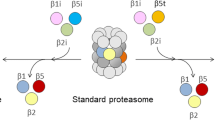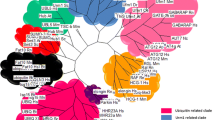Abstract
A phylogenetic analysis of proteasome subunits revealed two major families (α and β) which originated by an ancient gene duplication prior to the divergence of archaebacteria and eukaryotes. Numerous gene duplications have subsequently occurred in eukaryotes; at least nine of these duplications were shown to have occurred prior to the divergence of animals and fungi. In mammals, two genes encoding proteasome subunits (LMP2 and LMP7) are located in the major histocompatibility complex (MHC) region and play a specific role in generation of peptides for presentation by class I MHC molecules. Phylogenetic analysis of LMP7 and related sequences from mammals and lower vertebrates indicated that this locus arose by gene duplication prior to the divergence of jawed and jawless vertebrates; the time of this duplication was estimated to have been about 600 million years ago. The evolutionary history of the proteasome subunits provides support for a model of the evolution of new gene function postulating that, after gene duplication, the proteins encoded by daughter loci can adapt to specialized functions previously performed by the product of a single generalized ancestral locus.
Similar content being viewed by others
Author information
Authors and Affiliations
Additional information
Received: 19 August 1996 / Revised: 24 December 1996
Rights and permissions
About this article
Cite this article
Hughes, A. Evolution of the proteasome components. Immunogenetics 46, 82–92 (1997). https://doi.org/10.1007/s002510050245
Issue Date:
DOI: https://doi.org/10.1007/s002510050245




